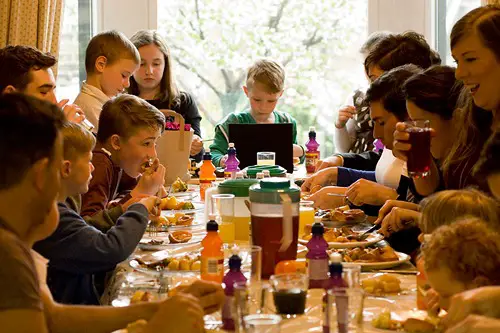1. Keeping Old Family Recipes Exactly the Same

Many families guard recipes like state secrets, insisting on strict fidelity to ingredients and methods. Older generations often believe a dish should never change—after all, it’s “how Grandma made it.” But younger cooks may want to modernize or adjust for dietary reasons, from gluten intolerance to veganism. When these changes are proposed, it can spark passive-aggressive pushback.
The real issue is control disguised as culinary tradition. Food is deeply emotional, and any tweak can feel like erasure to someone tied to the original. But for younger people, evolving recipes can be a way to keep them alive. Every clash over seasoning is a deeper conversation about memory, identity, and who gets to shape the story next.
2. Passing Down Fine China No One Uses

Grandparents often treasure their china sets, seeing them as family heirlooms and symbols of formality. But younger generations tend to favor practicality and minimalism, making ornate dishware feel more like clutter than tradition. This can spark tension when older relatives expect reverence for these items, while younger ones might quietly resent the storage hassle. Often, the china never leaves the cabinet—it’s a relic of a time when formal dinners were the norm.
The root of the tension isn’t just about plates; it’s about differing values. One generation sees continuity, the other sees inconvenience. Some millennials even joke about “inheriting a burden” when gifted these pieces. It’s a subtle but telling rift between preservation and reinvention.
3. Sunday Family Dinners That Feel Like Obligations

Weekly family meals are meant to bring people together, and older generations often see them as sacred time. But younger family members may feel these dinners are more performative than bonding, especially if outdated norms (like women doing all the cooking) are enforced. The expectation to attend every week can feel heavy, even if no one says it aloud. This silent pressure often causes quiet resentment that goes unspoken to avoid drama.
For many millennials and Gen Zers, boundaries and mental health come first. They might crave more flexible, intentional time with family rather than mandatory gatherings. When older relatives interpret absences as disrespect, it exposes generational misalignment. These dinners aren’t just meals—they’re emotional battlegrounds with casseroles.
4. Saving Wrapping Paper “For Later”

For many in the older generations, saving used wrapping paper is second nature—thriftiness born from post-war or Depression-era mindsets. But for younger adults raised in a culture of disposability and ease, this tradition feels excessive or even mildly absurd. There’s often confusion or quiet judgment during the unwrapping process when someone tries to peel off tape carefully rather than ripping with joy. The act becomes less about reuse and more about a clash in values.
At its heart, this tradition underscores a deeper divide in how each generation views waste and sustainability. While Gen Z may care deeply about the environment, their methods—like composting or digital gift cards—are different. They might see reusing paper as outdated when eco-friendly options exist. The result is a disconnect masked as a quirky household habit.
5. Saving Everything “Just in Case”

Older relatives often keep bags full of other bags, drawers full of twist ties, and closets of clothes from decades past. This behavior, shaped by eras of scarcity, is often viewed as prudent by them. Younger generations, raised amid KonMari and decluttering culture, often interpret it as hoarding. The result is a quiet tug-of-war over what’s worth keeping.
When younger family members try to help organize or downsize, they might encounter resistance and even emotional backlash. The clutter isn’t just stuff—it’s tied to memory, control, and fear of waste. But younger folks see mental clarity and ease in letting go. These opposing views can lead to simmering frustration masked as polite conversation.
6. Keeping “The Good Towels” for Guests Only

Many families have a set of plush, pristine towels that no one in the house is allowed to use—except guests. This practice dates back to a time when impressing visitors was a sign of hospitality and pride. For younger generations who prioritize authenticity over appearances, it can feel performative or even hypocritical. Why save the best for strangers while using frayed ones every day?
Younger family members might feel this tradition reflects outdated priorities. They’re more likely to embrace self-care and use nice things now rather than waiting for a rare occasion. The clash often reveals differing beliefs about worth and presentation. In these towels, you can literally see the gap in what each generation values most.
7. Mandatory Holiday Cards

Sending physical holiday cards used to be a seasonal ritual, especially for boomers and older Gen Xers. But for younger adults accustomed to digital communication, it feels like a lot of time, effort, and money for something that usually ends up in the trash. When family members push others to participate, it can create subtle guilt and quiet pushback. The deeper issue is often about maintaining a public-facing image of cohesion.
Digital natives might prefer sending a text, photo, or even a personalized video. But these options are sometimes dismissed as lazy or impersonal by older relatives. The card becomes symbolic—a way of measuring who’s “putting in the effort.” What’s intended as a unifier can become a quiet wedge.
8. Expecting Phone Calls Instead of Texts

Many older adults still expect regular phone calls as a sign of respect and love. But younger generations often communicate in shorter, more frequent bursts via text, voice memos, or social media. When these habits collide, misunderstandings and hurt feelings can arise—even if no one says anything outright. Silence on the phone becomes a perceived slight rather than a difference in communication style.
Younger people might feel that emotional closeness doesn’t require long conversations. But older relatives may interpret that as detachment or laziness. It’s not just about how we talk, but what kind of presence we believe matters. This small difference quietly reveals how each generation defines connection.
9. Inheriting Furniture No One Wants

Antique armoires, heavy dining sets, and floral couches often get passed down with sentimental weight. Older generations view these pieces as family treasures, while younger folks—especially those living in smaller spaces—see them as design clashes and logistical burdens. Refusing them can spark guilt or disappointment. But accepting them often means sacrificing personal taste or practicality.
This tradition highlights a deeper tension around legacy and lifestyle. Boomers may see furniture as a symbol of roots and permanence, while millennials and Gen Z lean toward mobility and choice. A dining table isn’t just a table—it’s a generational statement. The rejection of these pieces can feel like a rejection of the past.
10. Gendered Chore Expectations

Many families fall into traditional gender roles when it comes to household chores, especially during gatherings. Grandmothers and mothers often cook and clean while grandfathers and fathers relax or handle “manly” tasks like grilling or yard work. Younger generations, especially those embracing egalitarian values, may find this division archaic or even offensive. Tension arises when these roles are enforced without conversation.
Millennials and Gen Zers often prefer to divvy tasks based on skill or availability, not gender. But disrupting the “flow” of long-established roles can make elders uncomfortable or defensive. The quiet conflict isn’t just about dishes—it’s about feminism, identity, and change. And often, no one wants to be the one to bring it up.
11. Pushing Religious Traditions Without Question

Religious observances—like attending church every Sunday or saying grace before meals—are often passed down without much room for reinterpretation. Older generations may feel these practices are non-negotiable parts of family life. But younger adults might identify as spiritual but not religious, or reject organized religion altogether. When they go along to keep the peace, tension simmers under the surface.
The conflict here is existential more than logistical. Participation becomes less about belief and more about appeasement. Younger people may fear disappointing their elders, while elders fear a loss of tradition. It’s a quiet standoff between conviction and compassion.
12. Keeping a “Formal Living Room” No One Uses

Some homes still have a living room that’s largely decorative—white couches, glass tables, and a general “don’t touch” vibe. This setup was common in mid-century and postwar homes as a symbol of success and order. But younger generations often find it impractical or cold, preferring multifunctional spaces where everyone feels comfortable. The room becomes a physical metaphor for unspoken rules.
When younger folks question why a whole room goes unused, it can spark defensiveness or confusion. The space is sacred to some, irrelevant to others. It’s less about the room itself and more about what it represents—structure, status, and a bygone version of adulthood. Every untouched cushion tells a story of values not quite aligning.
13. Holiday Décor That Never Changes

Many households keep using the same holiday decorations year after year—sometimes for decades. Grandparents might insist on the ceramic tree or tinsel garlands that feel comforting to them but garish or outdated to younger eyes. What feels nostalgic to one person can feel suffocating or uninspired to another. The décor becomes symbolic of deeper resistance to change.
Younger generations might prefer more curated or minimalist decorations, often inspired by Pinterest or social media aesthetics. But changing up the décor can lead to accusations of being “too modern” or “killing tradition.” It’s less about tinsel and more about who gets to define the family’s sense of identity. Every ornament tells a story, and not all stories agree.
This post 13 Household Traditions That Quietly Reveal Intergenerational Tension was first published on Greenhouse Black.
